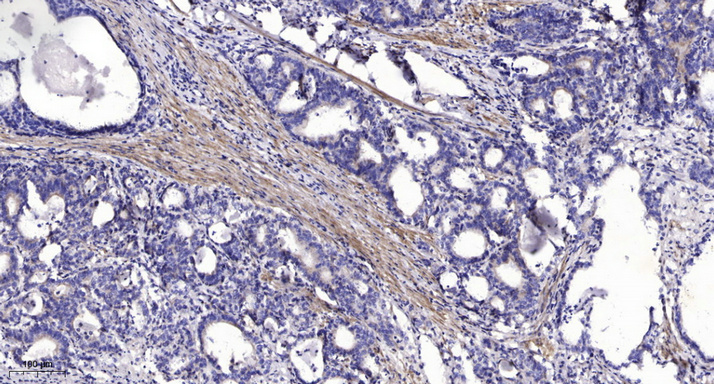Lck BP-1 Polyclonal Antibody
- Catalog No.:YT5013
- Applications:WB;IHC
- Reactivity:Human;Mouse
- Target:
- Lck BP-1
- Fields:
- >>Tight junction;>>Bacterial invasion of epithelial cells;>>Pathogenic Escherichia coli infection;>>Shigellosis;>>Proteoglycans in cancer
- Gene Name:
- HCLS1
- Protein Name:
- Hematopoietic lineage cell-specific protein
- Human Gene Id:
- 3059
- Human Swiss Prot No:
- P14317
- Mouse Swiss Prot No:
- P49710
- Immunogen:
- Synthesized peptide derived from Lck BP-1 . at AA range: 340-420
- Specificity:
- Lck BP-1 Polyclonal Antibody detects endogenous levels of Lck BP-1 protein.
- Formulation:
- Liquid in PBS containing 50% glycerol, 0.5% BSA and 0.02% sodium azide.
- Source:
- Polyclonal, Rabbit,IgG
- Dilution:
- WB 1:500-2000;IHC 1:50-300
- Purification:
- The antibody was affinity-purified from rabbit antiserum by affinity-chromatography using epitope-specific immunogen.
- Concentration:
- 1 mg/ml
- Storage Stability:
- -15°C to -25°C/1 year(Do not lower than -25°C)
- Other Name:
- HCLS1;HS1;Hematopoietic lineage cell-specific protein;Hematopoietic cell-specific LYN substrate 1;LckBP1;p75
- Observed Band(KD):
- 54kD
- Background:
- developmental stage:Expressed in early stage of myeloid and erythroid differentiation.,function:Substrate of the antigen receptor-coupled tyrosine kinase. Plays a role in antigen receptor signaling for both clonal expansion and deletion in lymphoid cells. May also be involved in the regulation of gene expression.,PTM:Phosphorylated by LYN; rapidly after cross-linking of surface IgM on B-cells.,similarity:Contains 1 SH3 domain.,similarity:Contains 4 cortactin repeats.,subunit:Associates with the SH2 and SH3 domains of LCK. Binding to he LCK SH3 domain occurs constitutively, while binding to the LCK SH2 domain occurs only upon TCR stimulation. A similar binding pattern was observed with LYN, but not with FYN in which the FYN SH2 region associates upon TCR stimulation but the FYN SH3 region does not associate regardless of TCR stimulation. Directly associates with HAX1, through binding to its C-terminal region. Interacts with HS1BP3.,tissue specificity:Expressed only in tissues and cells of hematopoietic origin.,
- Function:
- developmental stage:Expressed in early stage of myeloid and erythroid differentiation.,function:Substrate of the antigen receptor-coupled tyrosine kinase. Plays a role in antigen receptor signaling for both clonal expansion and deletion in lymphoid cells. May also be involved in the regulation of gene expression.,PTM:Phosphorylated by LYN; rapidly after cross-linking of surface IgM on B-cells.,similarity:Contains 1 SH3 domain.,similarity:Contains 4 cortactin repeats.,subunit:Associates with the SH2 and SH3 domains of LCK. Binding to he LCK SH3 domain occurs constitutively, while binding to the LCK SH2 domain occurs only upon TCR stimulation. A similar binding pattern was observed with LYN, but not with FYN in which the FYN SH2 region associates upon TCR stimulation but the FYN SH3 region does not associate regardless of TCR stimulation. Directly associates with HAX1, through binding to i
- Subcellular Location:
- Membrane ; Peripheral membrane protein . Cytoplasm . Mitochondrion .
- Expression:
- Expressed only in tissues and cells of hematopoietic origin.
- June 19-2018
- WESTERN IMMUNOBLOTTING PROTOCOL
- June 19-2018
- IMMUNOHISTOCHEMISTRY-PARAFFIN PROTOCOL
- June 19-2018
- IMMUNOFLUORESCENCE PROTOCOL
- September 08-2020
- FLOW-CYTOMEYRT-PROTOCOL
- May 20-2022
- Cell-Based ELISA│解您多样本WB检测之困扰
- July 13-2018
- CELL-BASED-ELISA-PROTOCOL-FOR-ACETYL-PROTEIN
- July 13-2018
- CELL-BASED-ELISA-PROTOCOL-FOR-PHOSPHO-PROTEIN
- July 13-2018
- Antibody-FAQs
- Products Images

- Immunohistochemical analysis of paraffin-embedded human Gastric adenocarcinoma. 1, Antibody was diluted at 1:200(4° overnight). 2, Tris-EDTA,pH9.0 was used for antigen retrieval. 3,Secondary antibody was diluted at 1:200(room temperature, 45min).



